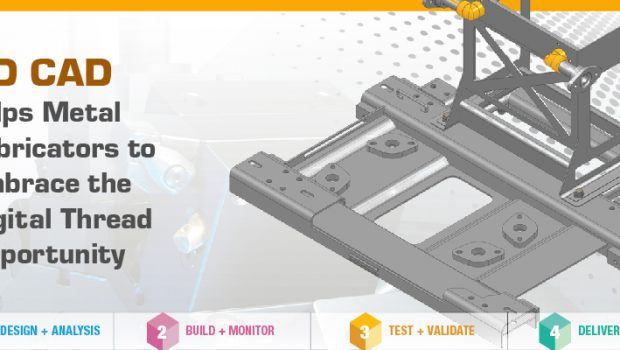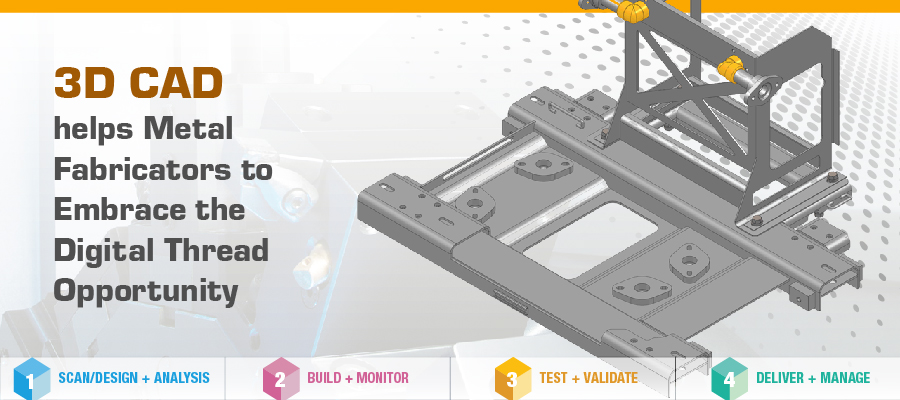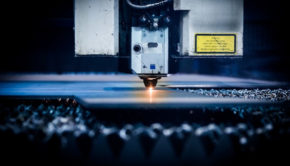3D CAD helps Metal Fabricators to Embrace the Digital Thread Opportunity
The future of industry is digital. Often termed as the “digital thread” – a single data source covering the design from concept to finished parts holds a great potential for the metal fabrication sector. The data-driven advantage with digital thread can enable fabricators to make a quantum leap in productivity, quality and machine efficiency.
For continuous improvement, going digital is indeed the next step for fabricators to implement best manufacturing processes and practices through machine to machine communication and automation. Job status with real time response to production situations like alerts when inventory of consumables reaches low level, generating predictive maintenance schedules, sending the stock information to suppliers, or sharing basic manufacturability data and feedback to engineers, the digital thread has the potential to eliminate greatest bottlenecks for fabrication businesses.
Large fabricators and manufacturing companies are already leading the pursuit of digital thread, making it inevitable for small part suppliers to implement right processes to avoid losing customers.
Consider a scenario where a shop purchases a new press with new tooling capability. For a digital approach, the company integrates sensors that collect information on new tools, stroke capabilities of press and other critical information that can be used for performing manufacturability analysis. The analyzed data is then made readily available in a shared database for product design and the design engineer working on the product. This ensures that there is a qualified component library available for the designer so that whatever he designs can be actually made.
The digital thread however begins with a 3D CAD model, which drives more than just part’s manufacturing process. But shifting to digital isn’t that easy; the conventional fabrication sector lags behind the consumer sector in terms of digital maturity.
A recent survey from National Institute of Standards and Technology (NIST) reveals that 90% of small manufacturers still rely on traditional 2D design approach to develop their products. The institute estimates that shifting from 2D to 3D for digital thread could reduce the production time by at least 70%.
IndiaCADworks provides outsourcing services in CAD design, conversion, and allied services to clients around the world. IndiaCADworks has been in the CAD Conversion services space for 11 years and has worked with more than 400 clients to date.
How Fabricators Should Respond?
The very basic requirement for fabricators to embrace the digital thread opportunity is to start thinking and designing in 3D. From converting the legacy 2D information into 3D and adding informative data to these models, which is often discarded, can unlock enormous value and change the fabrication processes entirely for greater level of productivity. Companies that can close this gap by tapping the data they generate can drive significant growth and profits. It is important for fabricators to understand they no longer sell parts but are selling their ability to partner and communicate with customers. It is more about information than just parts or assemblies.
Consider an example of Uber, the world’s largest taxi company. The company does not meet customers’ requirement of moving them from point A to point B with steel, glass or rubber, but through the use of data to match the riders with vehicles through smart phones. So is the case with Airbnb. The company has got no rooms, but is still the largest hospitality provider.
One thing that’s common in these companies is that they’re essentially information companies and that is where the difference lies between a fabricator that’s leading today and the one that’s struggling to maintain competitiveness. It is thus crucial for fabricators to wake up to the opportunities with digital data and start scrutinizing on how and in what form the information reaches the floor and how quickly and often does that happen. And, that is possible only through the adoption of 3D methods across the value chain.
Metal fabricators can successfully transition their processes from an “old school” 2D to 3D, MBD (Model Based Definition) and beyond through collaboration with partners that can help in taking the steps towards digital thread.
A partnership will enable fabricators to get answers to three important questions about digital:
- Where exactly the value of digital is in the company and how that value can be maximized?
- Where to make investments? (E.g. infrastructure, cybersecurity, partnerships, etc.)
- What new capabilities, skills and trainings will be needed in the organization?
Solving the longstanding, traditional industry challenges for true digital transformation means getting out of the everyday problems, reaching out to people outside the organization and maybe even getting little uncomfortable.
The leap towards reaping the benefits of digital thread is difficult, but early movers are also expected to witness greater benefits. 3D model is the first step in this direction; it is the model that actually begins the digital conversation to connect the traditionally separated engineering and fabrication processes.
About the Author:

Kashyap Vyas is an Engineer at Hi-Tech CADD Services and holds a Master’s degree in Thermal Engineering with several research papers to his credit. He covers CAD and CAE topics for the engineering industry. His contributions are primarily focused on encouraging manufacturers and suppliers to adopt virtual product development tools to build efficient products with reduced time-to-market.










![Marketing Lessons from Apple [Infographic]](https://technofaq.org/wp-content/uploads/2018/10/Apple-Marketing-Infographic-thumb-150x150.jpg)






One Response to 3D CAD helps Metal Fabricators to Embrace the Digital Thread Opportunity